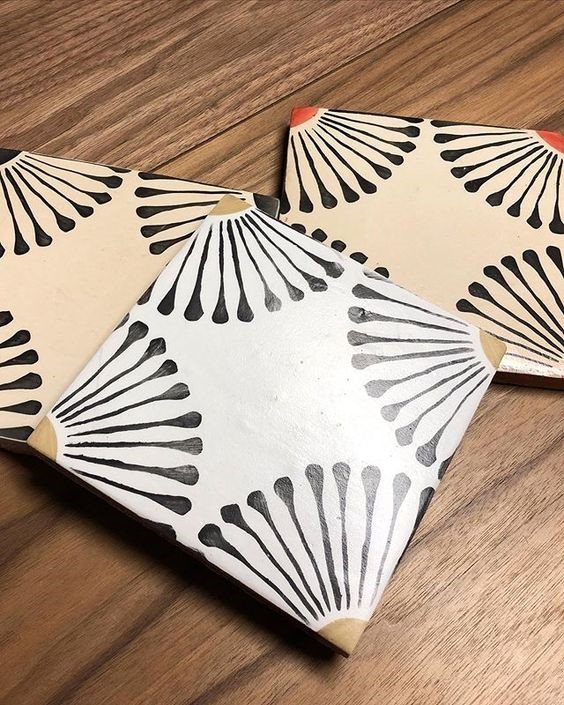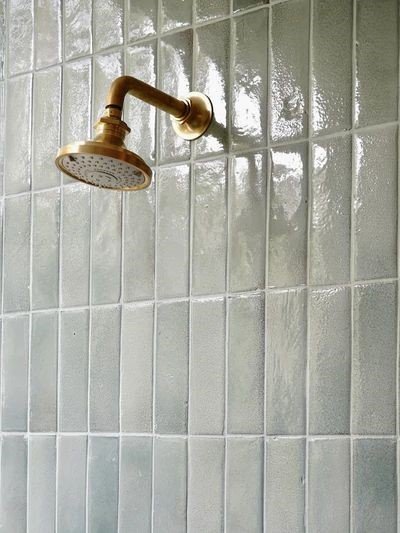Terracotta tiles have a rich historical and cultural significance. While modern alternatives like laminates have gained popularity, terracotta is making a comeback. Terracotta is a sustainable and an easily maintainable option. These tiles possess an old-world charm that other materials lack. Let’s explore more about these earthy tiles that add warmth and character to your home.

Source: Pinterest (tabarkastudio.com)
See also: Tiles for Floor: A list of Different Types and Designs.
Terracotta tiles: Characteristics
Composition and material properties
- Made from natural clay and minerals.
- Fired at high temperatures to achieve strength and durability.
- Typically contains iron oxide, which gives it a reddish-brown colour.
- Non-porous and moisture-resistant, making them suitable for indoor and outdoor use.
Colour variations and finishes
- Available in various earthy tones, including reddish-brown, tan and grey.
- Glazed terracotta tiles offer a glossy surface and vibrant colours, while unglazed ones look more rustic.
Sizes, shapes, and patterns available
- Common shapes include squares, rectangles and hexagons.
- Different sizes are available, ranging from small mosaic tiles to large formats.
- Patterns can vary, including plain, textured or decorative designs.
Durability and resistance
- They are highly durable and long-lasting due to their fired composition.
- Resistant to fading, chipping and scratches.
- They withstand heavy foot traffic and are suitable for residential and commercial areas.
- Can endure extreme temperature variations without warping or cracking.
Terracotta tiles: Types
Traditional terracotta

Source: Pinterest (tabarkastudio.com)
Traditional terracotta tiles are timeless and rustic in appearance. They are made from natural clay and have a warm, earthy colour. They are typically unglazed and come in earthly tones like red, brown and orange. These tiles are durable and offer a traditional and timeless aesthetic often used in Mediterranean and rustic-style architecture.
Glazed terracotta

Source: Pinterest (Clay Imports)
Glazed terracotta tiles have been coated with a layer of glaze. This glaze adds a glossy finish to the tiles and provides enhanced durability and resistance to strains and scratches. Glazed terracotta tiles come in various colours and patterns, allowing for more design options.
Terracotta tiles: Applications and uses
- Terracotta tiles are commonly used for flooring in residential and commercial buildings.
- They provide a warm and rustic appearance, adding a touch of elegance to any space.
- Terracotta tiles are durable and long-lasting, making them suitable for high-traffic areas.
- Terracotta tiles have excellent thermal properties, helping to regulate indoor temperatures.
- Terracotta tiles can be used in various architectural styles, from traditional to contemporary.
- They offer excellent acoustic properties, reducing noise transmission and enhancing the overall acoustic comfort of a space.
Terracotta tiles: Maintenance and care
- Regular sweeping or vacuuming to remove dust and dirt.
- Mopping with a mild, pH-neutral cleaner and water to remove stains and spills.
- Avoid using harsh chemicals or abrasive cleaners that can damage the tiles.
- Apply a sealant or wax periodically to protect the tiles and enhance their appearance.
- Avoid dragging heavy furniture or objects across the tiles to prevent scratching.
- Use doormats at entryways to minimise dirt and debris being tracked onto the tiles.
- Avoid exposing terracotta tiles to excessive moisture or standing water.
- Regularly inspect and repair any cracks or chips to prevent further damage.
- Follow the manufacturer’s instructions for specific maintenance guidelines.
Terracotta tiles: Limitations and considerations
Fragility: Terracotta tiles can be brittle and prone to cracking or chipping, especially if subjected to heavy impact or weight.
Porosity: Terracotta tiles are porous, absorbing water and other liquids readily. It makes them susceptible to staining and can damage if improperly sealed and maintained.
Limited colour options: Terracotta tiles usually come in earthy, reddish-brown tones. While this can appeal to some, it may limit design possibilities for those seeking a more comprehensive range of colours.
Susceptibility to temperature changes: Extreme fluctuations can cause terracotta tiles to expand and contract. It leads to potential cracking or warping.
Weight: Terracotta tiles are relatively heavy compared to other flooring options. It may require additional structural support in some cases.
Cost: Terracotta tiles can be more expensive than other flooring options in terms of material costs and installation expenses.
FAQs
What are terracotta tiles made of?
Terracotta tiles are made up of natural clay and minerals. They are shaped and fired at high temperatures to achieve strength and durability.
Are terracotta tiles durable?
Yes, terracotta tiles are highly durable and resistant to fading, chipping, and scratches. They are suitable for heavy foot traffic, for residential and commercial uses.
Can terracotta tiles be used in wet areas like the bathroom and kitchen?
Glazed terracotta tiles are resistant to stains and moisture, making them suitable for bathrooms and kitchens. However, proper sealing and maintenance are necessary to protect the tiles from water damage.
Do terracotta tiles offer any other benefits?
Terracotta tiles have excellent thermal properties, helping to regulate indoor temperatures. They also offer excellent acoustic properties, reducing noise transmission and enhancing the overall acoustic comfort of a space.
| Got any questions or point of view on our article? We would love to hear from you. Write to our Editor-in-Chief Jhumur Ghosh at [email protected] |
Housing News Desk is the news desk of leading online real estate portal, Housing.com. Housing News Desk focuses on a variety of topics such as real estate laws, taxes, current news, property trends, home loans, rentals, décor, green homes, home improvement, etc. The main objective of the news desk, is to cover the real estate sector from the perspective of providing information that is useful to the end-user.
Facebook: https://www.facebook.com/housing.com/
Twitter: https://twitter.com/Housing
Email: [email protected]












